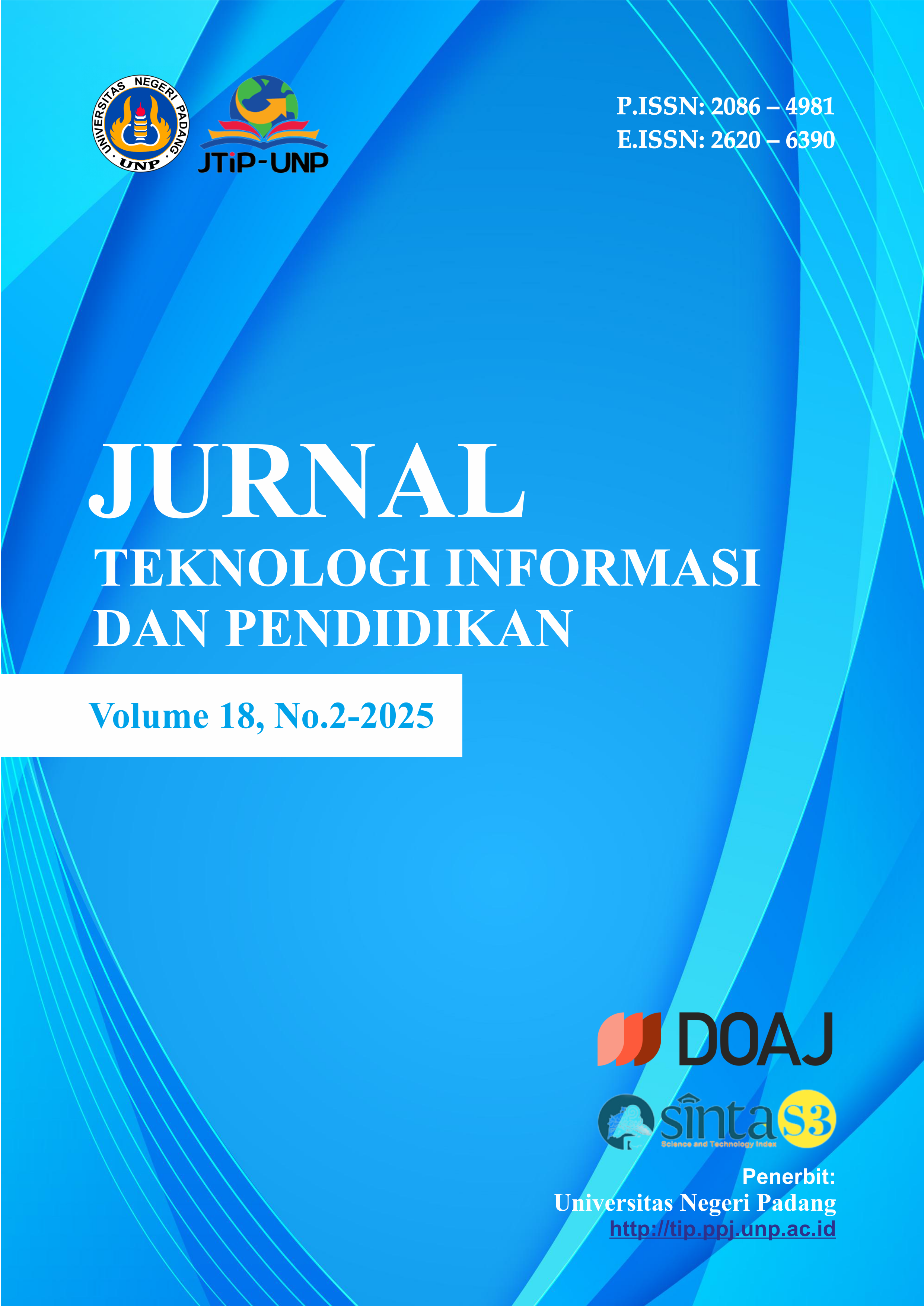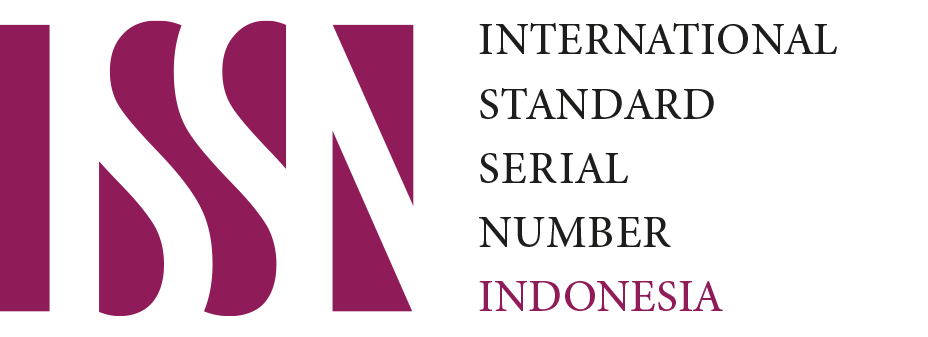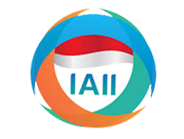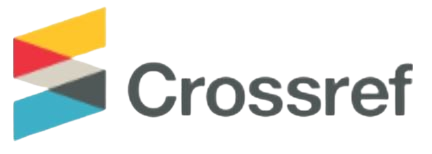Exploring the Influence of Programming Courses on University Students’ Computational Thinking Skills
DOI:
https://doi.org/10.24036/jtip.v18i2.977Keywords:
Computational thinking, Programming course, Correlational study, Learning assesmentAbstract
This study aims to explore the relationship between students' perceptions of programming courses and computational thinking (CT) skills in Information Systems Study Program students at Metamedia University. The sample consisted of 37 semester students in the 2024/2025 academic year. The research method used was quantitative with a correlational approach, and data analysis was carried out using the JASP application. The results of the Spearman's rho correlation test showed a value of 0.103 with a p-value of 0.590. This value indicates a very weak and insignificant relationship between perceptions of programming courses and CT skills, as measured by the Mid-Semester Exam scores. This finding indicates that although students have positive perceptions of programming courses, these perceptions are not necessarily directly proportional to their CT skills. This result contradicts initial expectations that assume a strong relationship between positive perceptions and increased CT skills. The implications of this study indicate the need to develop a learning approach that explicitly integrates CT elements in the learning process, assignments, and assessments in programming courses in higher education
References
M. Hilbert, “Digital technology and social change: the digital transformation of society from a historical perspective,” Dialogues Clin. Neurosci., vol. 22, no. 2, Jun. 2020, doi: 10.31887/DCNS.2020.22.2/mhilbert.
A. Shehaj, “Revolutionized learning: Education policy and digital reform in the eurozone,” Eur. Policy Anal., vol. 8, no. 3, Jun. 2022, doi: https://doi.org/10.1002/epa2.1158.
A. Siqi-Liu and T. Egner, “Contextual Adaptation of Cognitive Flexibility is driven by Task- and Item-Level Learning,” Cogn. Affect. Behav. Neurosci., vol. 20, no. 4, pp. 757–782, 2020, doi: 10.3758/s13415-020-00801-9.
B. Rienties, “Defining the Boundaries Between Artificial Intelligence in Education, Computer-Supported Collaborative Learning, Educational Data Mining, and Learning Analytics: A Need for Coherence,” 2020. doi: 10.3389/feduc.2020.00128.
I. W. Widiana, I. W. Lasmawan, and I. G. P. Suharta, “Curriculum Transformation Towards Future Education,” Prism. Magistra J. Ilm. Kependidikan, vol. 6, no. 2, pp. 122–132, 2025.
R. Darwas, R. Sepriana, A. Yulastri, D. Irfan, and N. Jalinus, “Pengaruh Project Based Learning Terhadap Kemampuan Berpikir Peserta Didik: Studi Meta Analisis,” Nusant. J. Pendidik. Indones., vol. 5, no. 1, 2025, doi: https://doi.org/10.62491/njpi.2025.v5i1-3.
R. H. Mardhiyah, S. N. F. Aldriani, F. Chitta, and M. R. Zulfikar, “Pentingnya Keterampilan Belajar di Abad 21 sebagai Tuntutan dalam Pengembangan Sumber Daya Manusia,” Lect. J. Pendidik., vol. 12, no. 1, pp. 29–40, May 2021, doi: 10.31849/lectura.v12i1.5813.
A. A. Ogegbo and R. Umesh, “A Systematic Review of Computational Thinking in Science Classrooms,” 2022. doi: 10.1080/03057267.2021.1963580.
Y. A. Rodríguez del Rey, I. N. Cawanga Cambinda, C. Deco, C. Bender, R. Avello‐Martínez, and K. O. Villalba‐Condori, “Developing computational thinking with a module of solved problems,” Comput. Appl. Eng. Educ., vol. 29, no. 3, pp. 506–516, May 2021, doi: 10.1002/CAE.22214’)).
S. Bartoloni et al., “Towards designing society 5.0 solutions: The new Quintuple Helix - Design Thinking approach to technology,” Technovation, vol. 113, p. 102413, May 2022, doi: 10.1016/J.TECHNOVATION.2021.102413.
N. O. Ezeamuzie and J. S. C. Leung, “Computational Thinking Through an Empirical Lens: A Systematic Review of Literature,” J. Educ. Comput. Res., vol. 60, no. 2, pp. 481–511, 2021, doi: https://doi.org/10.1177/07356331211033158.
A. Sjödahl and A. Eckert, “Abstracting and decomposing in a visual programming environment - ScienceDirect,” Int. J. Child-Computer Interact., vol. 36, May 2023, doi: https://doi.org/10.1016/j.ijcci.2023.100573.
D. Weintrop, M. Shandra, and M. and Subramaniam, “Assessing computational thinking in libraries,” Comput. Sci. Educ., vol. 31, no. 2, pp. 290–311, May 2021, doi: 10.1080/08993408.2021.1874229.
I. Lee, “Computational Thinking from a Disciplinary Perspective: Integrating Computational Thinking in K-12 Science, Technology, Engineering, and Mathematics Education,” J. Sci. Educ. Technol., vol. 29, no. 1, pp. 1–8, 2020, doi: 10.1007/s10956-019-09803-w.
Z. Katai, “Promoting computational thinking of both sciences- and humanities-oriented students: an instructional and motivational design perspective,” Educ. Technol. Res. Dev., vol. 68, no. 5, pp. 2239–2261, 2020, doi: 10.1007/s11423-020-09766-5.
Y. Li, “Computational Thinking Is More about Thinking than Computing,” 2020. doi: 10.1007/s41979-020-00030-2.
W. Deng, “Pencil Code improves learners’ computational thinking and computer learning attitude,” Comput. Appl. Eng. Educ., vol. 28, no. 1, pp. 90–104, 2020, doi: 10.1002/cae.22177.
Y.-F. Liu, J. Kim, C. Wilson, and M. Bedny, “Computer code comprehension shares neural resources with formal logical inference in the fronto-parietal network,” Elife, vol. 9, p. e59340, May 2020, doi: 10.7554/eLife.59340.
Y. Zhuang, L. Yu-Hsuan, L. Mahesh, S. Andito Haryo, U. Yuniati Dwi, and J.-H. and Wang, “An interactive programming learning environment supporting paper computing and immediate evaluation for making thinking visible and traceable,” Interact. Learn. Environ., vol. 32, no. 9, pp. 5253–5266, May 2024, doi: 10.1080/10494820.2023.2212709.
G. Mecca, D. Santoro, N. Sileno, and E. Veltri, “Diogene-CT: tools and methodologies for teaching and learning coding,” Int. J. Educ. Technol. High. Educ., vol. 18, no. 1, pp. 1–26, 2021, doi: 10.1186/s41239-021-00246-1.
N. Pellas, “Enhancing Computational Thinking, Spatial Reasoning, and Executive Function Skills: The Impact of Tangible Programming Tools in Early Childhood and Across Different Learner Stages,” J. Educ. Comput. Res., vol. 63, no. 1, 2025, doi: https://doi.org/10.1177/07356331241292767.
C. Cachero, P. Barra, S. Meliá, and O. López, “Impact of Programming Exposure on the Development of Computational Thinking Capabilities: An Empirical Study,” IEEE Access, vol. 8, pp. 72316–72325, May 2020, doi: 10.1109/ACCESS.2020.2987254.
R. C. Coelho, M. F. P. Marques, and T. de Oliveira, “Mobile Learning Tools to Support in Teaching Programming Logic and Design: A Systematic Literature Review,” Informatics Educ., vol. 22, no. 4, pp. 589–612, May 2023, doi: 10.15388/infedu.2023.24.
C. Y. Tsai and Y. C. Lai, “Design and Validation of an Augmented Reality Teaching System for Primary Logic Programming Education,” Sensors, vol. 22, no. 1, May 2022, doi: https://doi.org/10.3390/s22010389.
C. M. Amerstorfer and C. Freiin von Münster-Kistner, “Student Perceptions of Academic Engagement and Student-Teacher Relationships in Problem-Based Learning,” Front. Psychol., vol. 12, no. October, pp. 1–18, 2021, doi: 10.3389/fpsyg.2021.713057.
N. O. Ezeamuzie, “Abstractive-Based Programming Approach to Computational Thinking: Discover, Extract, Create, and Assemble,” J. Educ. Comput. Res., vol. 61, no. 3, May 2023, doi: https://doi.org/10.1177/07356331221134.
W. Xing and X. Wang, “Understanding students’ effective use of data in the age of big data in higher education: Behaviour & Information Technology: Vol 41 , No 12 - Get Access,” May 29, 2022. [Online]. Available: https://www.tandfonline.com/doi/full/10.1080/0144929X.2021.1936176
Z. Guo, “Causal inference with invalid instruments: post-selection problems and a solution using searching and sampling,” J. R. Stat. Soc., vol. 85, no. 3, May 2023, doi: https://doi.org/10.1093/jrsssb/qkad049.
I. W. Gunada, W. Jufri, and S. Idawati, “Validitas dan Reliabilitas Instrumen Pemahaman Nature Of Science Mahasiswa Calon Guru,” J. Pendidikan, Sains, Geol. dan Geofis., vol. 6, no. 2, 2025, doi: https://doi.org/10.29303/Goescienceed.v6i2.1041.
R. Purwasih, R. Rahimullaily, and A. I. Suryani, “Blended Learning Model in Improving 4C Abilities of Information System Students,” JPI (Jurnal Pendidik. Indones., vol. 10, no. 4, May 2021, doi: 10.23887/jpi-undiksha.v10i4.30939.
Downloads
Published
How to Cite
Issue
Section
License
Copyright (c) 2025 Jurnal Teknologi Informasi dan Pendidikan

This work is licensed under a Creative Commons Attribution-ShareAlike 4.0 International License.















.png)














